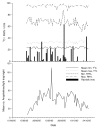Risk factors for house-entry by malaria vectors in a rural town and satellite villages in The Gambia
- PMID: 18179686
- PMCID: PMC2267476
- DOI: 10.1186/1475-2875-7-2
Risk factors for house-entry by malaria vectors in a rural town and satellite villages in The Gambia
Abstract
Background: In the pre-intervention year of a randomized controlled trial investigating the protective effects of house screening against malaria-transmitting vectors, a multi-factorial risk factor analysis study was used to identify factors that influence mosquito house entry.
Methods: Mosquitoes were sampled using CDC light traps in 976 houses, each on one night, in Farafenni town and surrounding villages during the malaria-transmission season in The Gambia. Catches from individual houses were both (a) left unadjusted and (b) adjusted relative to the number of mosquitoes caught in four sentinel houses that were operated nightly throughout the period, to allow for night-to-night variation. Houses were characterized by location, architecture, human occupancy and their mosquito control activities, and the number and type of domestic animals within the compound.
Results: 106,536 mosquitoes were caught, of which 55% were Anopheles gambiae sensu lato, the major malaria vectors in the region. There were seven fold higher numbers of An. gambiae s.l. in the villages (geometric mean per trap night = 43.7, 95% confidence intervals, CIs = 39.5-48.4) than in Farafenni town (6.3, 5.7-7.2) and significant variation between residential blocks (p < 0.001). A negative binomial multivariate model performed equally well using unadjusted or adjusted trap data. Using the unadjusted data the presence of nuisance mosquitoes was reduced if the house was located in the town (odds ratio, OR = 0.11, 95% CIs = 0.09-0.13), the eaves were closed (OR = 0.71, 0.60-0.85), a horse was tethered near the house (OR = 0.77, 0.73-0.82), and churai, a local incense, was burned in the room at night (OR = 0.56, 0.47-0.66). Mosquito numbers increased per additional person in the house (OR = 1.04, 1.02-1.06) or trapping room (OR = 1.19, 1.13-1.25) and when the walls were made of mud blocks compared with concrete (OR = 1.44, 1.10-1.87).
Conclusion: This study demonstrates that the risk of malaria transmission is greatest in rural areas, where large numbers of people sleep in houses made of mud blocks, where the eaves are open, horses are not tethered nearby and where churai is not burnt at night. These factors need to be considered in the design and analysis of intervention studies designed to reduce malaria transmission in The Gambia and other parts of sub-Saharan Africa.
Figures


References
-
- Takken W, Lindsay SW. Factors affecting the vectorial competence of Anopheles gambiae: a question of scale. In: Takken W, Scott TW, editor. Ecological Aspects for Application of Genetically Modified Mosquitoes Proceedings of the Frontis Workshop on Ecological Challenges Concerning the Use of Genetically Modified Mosquitoes for Disease Control: 26–29 June 2002; Wageningen, The Netherlands. Frontis-Wageningen International Nucleus for Strategic Expertise, Wageningen University and Research Centre, Wageningen, The Netherlands; 2003. pp. 2075–2090.
-
- Bødker R, Akida J, Shayo D, Kisinza W, Msangeni HA, Pedersen EM, Lindsay SW. Relationship between altitude and intensity of malaria transmission in the Usambara Mountains, Tanzania. J Med Entomol. 2003;40:706–717. - PubMed
Publication types
MeSH terms
Grants and funding
LinkOut - more resources
Full Text Sources
Medical

